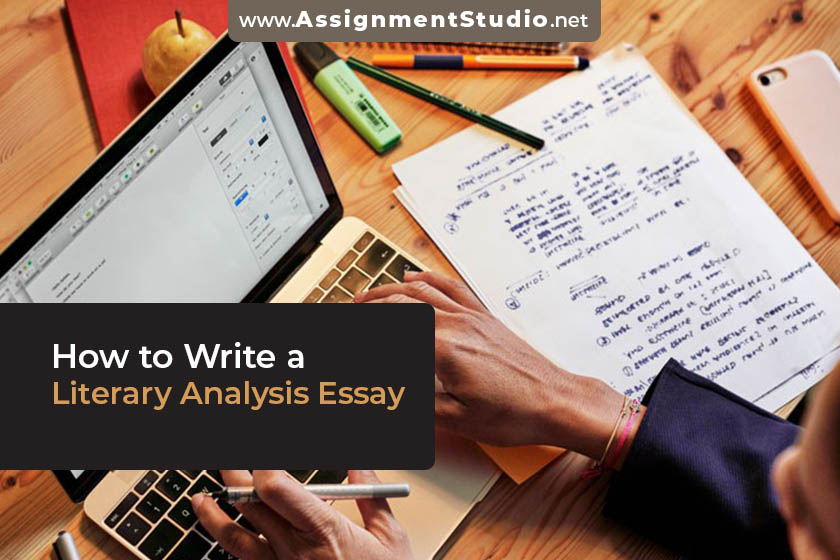
Literary analysis essay directs evaluating a literature work. It refers to study a text, interpret the meanings, and then discover the reasons of why author has made certain choices. This can easily be applied to short stories, novels, poems, plays or other literary writing form.
It isn’t just a book review, plot summary or rhetorical analysis. Instead, it is considered as an argumentative essay type which analyzes elements like perspective, language, and text structure, also tells in what way the author make a use of literary devices to convey ideas and create effects. Prior starting a literary analysis essay, it is important to carefully read the text and make a thesis statement to keep the essay focused. For writing, use the academic essay standard structure:
- Introduction: It tells the reader about what the essay is centered on.
- Body Paragraphs: It is the main body that is divided into paragraphs depending on the number of arguments, using evidence from the text.
- Conclusion: It states the main point that is been shown with the analysis.
Table of Contents
Step 1: Read the Text to Identify Literary Devices
Read the text carefully and make notes. While reading, focus on the things or elements that seems confusing, surprising or intriguing in the writing- basically it can dig into the analysis.
The goal of literary analysis doesn’t only rely on explaining the events that is described in the text, however it analyze the writing and discuss ways the text works in depth. Mainly, it is a search for literary devices— the textual elements used by the writers to create effect and convey meaning or ideas. When comparing and contrasting multiple texts, connections between different texts can also be seen.
Several key areas should be focused on when starting with analysis. When analyzing each text, think about how they are related to each other. Use notes or highlights to keep track of significant quotes and passages.
Language Choices
Understand the language style that author uses. Is the sentence simple and short or poetic and complex?
Mark the word choices that stand out as unusual or maybe interesting? Is there a figurative use of word to refer something or the literal definition is used? Usually, figurative language comprises of simile (for example; “her lips were like butterflies”) metaphor (for example; “her lips were butterflies”)
Alongside, keep an eye out for imagery — that refers to recurring images which symbolize important thing or create certain atmosphere. Do know, that language used in literary texts has lot more to say what it actually reflects on the surface.
The Narrative Voice
For narrative voice, simply make a question to yourself;
- Who is narrating the story? and;
- How are they narrating it?
Check if it’s the first-person narrator (using the pronoun “I”) – personally involved in the story, or is it some third-person narrator – who is describing the characters in the text from a distance?
Take the narrator’s perspective. Check if the narrator has partial knowledge or they are omniscient (knows everything about events and characters)? Do they refer as an unreliable narrator to whom one can’t take at face value? There is a hint by authors most of the time that their narrator may give a dishonest or distorted version of events.
Under this, the text tone is worth considering. Does the story anticipate being tragic, comic, or other? Is the story fantastical, realistic or lie somewhere in between?
Structure
Check with the text structure, and how it relates to the story which is being told.
- Poems are mostly broken down into stanza, lines, and at times cantos.
- Novels are mostly broken down into parts and chapters.
- Plays are broken down into acts and scenes.
Consider why the author chose to break down different text parts in the manner they did.
Also, there are less formal structural elements that can be taken into consideration. Is the story jumping back and forth in time or unfolded in chronological order? Does it begin in the middle of the action? Check if the story plot advances towards a well-defined climax?
For poetry, check with how the meter and rhyme shape the text understanding and tone impression. Read aloud the poem to get a sense of it.
For play, check how character relationships are built up through different scenes and the way setting is related to the action. Beware of the dramatic irony, where audience is aware of little detail which the character doesn’t that forms a double meaning in their actions, thoughts or words.
Step 2: Come up with a Thesis in Literary Analysis
In literary analysis, the thesis is the point made about the text. Primarily, it is the core argument that provides the essay, a direction and averts it from only being a pool of text random observations.
If any essay prompt is given, the thesis should relate or answer the prompt such that;
For instance; the thesis statement has to be an answer to this question rather than being a yes or no. It should also come up with a statement of why it is or isn’t the case.
When given freedom to select own topic; then come up with an original thesis. Consider the elements that interest you and ways to answer them.
The thesis statement must be arguable – somewhat that is true for the text but merely not a matter of fact. It should be composite enough in order to build through arguments and evidence across the essay course.
For the time, the novel Frankenstein is analyzed. Begin asking yourself:
The answer could be a description at surface-level:
Though, the above statement is way simple to be considered as an interesting thesis. Right after going through the text and analyzing its structure, the answer can be developed into an arguable thesis statement:
Topic and Position
Thesis statement, first part goes with identifying the topic that the essay takes a clear position or focus on:
- That throughout the novel, there are changes to portrayal of Frankenstein.
- With the use of different narrative perspectives, it is achieved.
Evidence
It is the second part that concisely stretches the evidence from the text in order to support the position.
The thesis statement can be revised during writing process; therefore there is no urgent need to perfectly formulate it at this stage. The aim revolves around keeping you focused as the text is analyzed.
Finding Textual Evidence
Using textual evidence (particular text parts that demonstrate the point), essay will develop argument to support thesis statement. The evidence is then quoted and analyzed all over the essay to clearly explain the laid argument to the reader.
Prior writing, it can be useful to skim through the text in order to seek for pertinent quotations. Not necessarily you will use everything that has been found, but as you write, you may return to the text for more evidence. However, gathering textual evidence from the start allows structuring and assessing the arguments as if they’re convincing.
Step 3: Write the Title and Introduction
In order to begin with literary analysis paper, there is a need for two basic yet useful components which is; a good title, and a well-written introduction.
The title
The title must noticeably direct to what the literature analysis will pay focus on. Usually it involves authors name and the text that will be analyzed. Make sure to make it engaging and keep it as concise as possible.
A very common approach to the title can be by utilizing a pertinent quote from the text, that is followed by a colon and onwards the title.
You may at first struggle to come up with a good literary analysis essay title but it becomes relatively easier when you start writing the essay and develop a good sense of arguments.
- Fearful symmetry: quotation from the text
- The violence of creation: Analysis topic
- William Blake’s “The Tyger : Author and his work being analyzed
The Introduction
The essay introduction provides a quick overview on argument direction. This section should include essay structure, summary and thesis statement.
The introduction generally starts with a general statement about the author and text and then using this into thesis statement. Moreover, there is a way of referring to a commonly held idea about the text and demonstrate the way the thesis statement will contradict it, or widely concentrate on specific device which you intend to focus on.
Later you can end with a hint of what will be discussed in the essay main body. It refers to signposting. In longer essays, it will be more elaborated but in a short essay structure (paragraphs) this should not go about more than one sentence.
Opening Sentence
The introduction part unlocks with a usually held assumption about the text.
Thesis Statement
The thesis statement sums up the main argument that will be later discussed in the essay, also takes a position against the common assumption.
Signposting
It is a concise overview of the essay’s structure which explains the reader about what to expect from each part.
Often students prefer to write the introduction later in the writing process, though it isn’t the bad one to go for as you gain a clearer idea of the discussed arguments in all aspect, once writing is done.
Even if the introduction is written at first, after writing do skim this part to make sure it lines up with what is written throughout the essay. Edit where necessary.
Step 4: Write the Body Paragraphs of the Essay
The essay body is everything between the introduction and conclusion. It contains the textual evidence and arguments which supports them.
Body Paragraph Structure
At higher academic level, usually the typical structure of literary analysis essay comprises of five paragraphs; three body paragraphs, one of introduction and the last conclusion.
Each main body paragraph should focus on one particular topic. For the five-paragraph model, break down the essay argument into three core areas of analysis, which are all related to the thesis. Do remember; never include everything that you get an idea of, in the mind about the text. Incorporate only analysis which drives your argument.
The same principle is applied on a broader scale for longer essay. For instance, there are two or three sections in the main body with multiple paragraphs for each. Under these sections, there is a need to start new paragraphs at logical moments—the introduction of a new idea or a turn in the argument.
Topic Sentences
It’s crucial to use a topic sentence at the starting of each paragraph in order to keep the points focused.
A well-written or good topic sentence helps readers to scan at a glimpse of what paragraphs point about. Though, it can contrast, connect or introduce a new line of argument. Use of transition words like “moreover” or “however” is useful to build smooth transitions.
For instance, this topic sentence indicates that the paragraph would address the religious symbolism question, while the linking word such as “nevertheless” used, and point out a contrast to that with the preceding conclusion of the paragraph.
Use of Textual Evidence
A central point of literary analysis is to back up the arguments with pertinent text evidence. It introduces quotes from the text and describes the importance to the point.
Contextualizing quotes is crucial and to clearly explain why it is used. It must be correctly introduced and analyzed, and isn’t treated as self-explanatory:
Using a quote always isn’t necessary. Quoting is useful to discuss author’s language, however at times it has to be referred to structural elements or plot point which could not be captured in a short quote.
Taking these cases, it’s highly suitable summarize or paraphrase parts of the text—which is to define the pertinent part in own words:
Step 5: Write the Conclusion
Literary analysis conclusion must not introduce any new arguments or quotations. It’s all about smartly wrapping up the essay without repetitive sentences. In this section, the key points are summarized in order to highlight its importance to the reader.
An efficient manner to approach this section is to concisely summarize the key arguments, alongside stressing on the conclusion that have been arrived on, also highlighting the new perspective the thesis provides on the text:
Summary
The conclusion section begins with a concise recap of the points that have been earlier disused in the essay.
Concluding Point
Here, the central argument is highlighted which show how new perspective is contributed by analysis.
Significance
The conclusion finishes by relating the arguments of essay to broader ideas.
Literary Analysis Essay is an academic task that usually social science and literature students come across. It tend to check student`s ability to comprehend what another author aim to achieve in h/her work. Creating a well-structured and properly addressed analysis paper is impossible without reading in-between the lines and in-depth study of literary work. Also, it calls for applying best critical thinking skills. For students who are at beginners’ level and rarely have any idea about how it is done, they may take few days to create a properly formatted and well-structured paper. In these cases, it may turn into a nightmare resulting in frustration and stress for students. Understanding what challenges does student’s face, Assignment Studio offers literary analysis essay assistance, which is perfectly centered on assignment requirements. The impeccable online assignment help is offered at nominal price. As the writers have been addressing these challenges which students’ face for years, they have been successful in helping students all over the globe to improve their academic results. Looking for professional literary analysis essay help online? Don’t worry you have landed on the right place. Place your order to start a smooth academic journey now.






